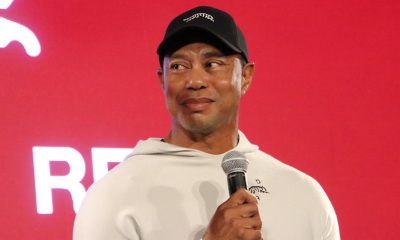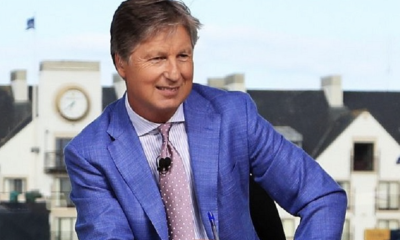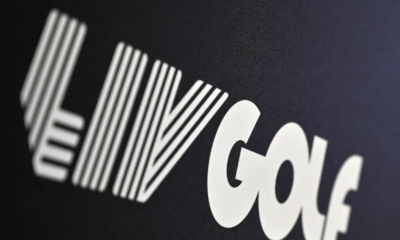Instruction
Clampett: Why golfers aren’t improving

The average golf score in the United States is still 100 and has been for over 50 years, despite better equipment, improved technologies, and course conditions. Touring pros continue to improve. Seemingly every week is a new tournament scoring record, despite courses getting longer and tougher. So why doesn’t the average golfer improve?
Two major problems exist, and when combined, set the perfect “stymie,” preventing game improvement. Sadly, it’s hurting the game and is responsible for why four million golfers quit every year and why 10 million want-to-be golfers lie waiting, wondering how to learn. The Five Golf Powers, which form the World Golf Federation, have done little to address this problem.
Problem #1
Style-based instruction is the predominant form of golf instruction and continues to confuse golfers. This epidemic has stifled game improvement and established a landscape of frustrated golfers. The search for the perfect style of swing and the desire to create certain “good looking” or “preferred styled” positions has led to countless books, videos, and teachers who taught their “ideal” style of swing. “Stack and Tilt,” “Single Plane Swing.” “Natural Golf Swing,” “The A-Swing,” “The X-Factor Swing,” “The Morad Project,” “The One or Two Plane Swing,” “The Gravity Golf Swing,” and the list of style-based teaching methods go on and on… Meanwhile, the best golfers in the world don’t subscribe to any of these swings.
Television adds to the confusion. An analyst may express his or her opinion about the best grip, setup, backswing, plane, downswing, follow-through, etc. One teacher says to do one thing, and the other contradicts it. Confusion abounds everywhere.
One day while on air at the Golf Channel, I had just finished discussing how to hit a bunker shot by keeping the same swing, just changing the set-up; when another instructor, with little playing credentials, followed me and shared with the viewers an entirely different swing that included throwing away clubhead lag and flipping at the bottom of the swing to hit a bunker shot. The poor viewer who watched that day and who couldn’t interpolate which way was better. How many viewers were confused? My goal is to eliminate the confusion, not be part of it. So, I refused to join the Golf Channel on TV in that capacity anymore.
Today’s average golfer gets much of their information online, surfing the internet and watching YouTube videos while being bombarded with countless emails produced by golf instructors who deliver “swing tips” to promote their business. Contradictory views confuse undereducated golfers searching for clues to playing better golf. Desperate, they head to the driving range, ready to apply whatever they just read, but it rarely helps and never lasts.
Problem #2
Since I left the PGA Tour and PGA Tour Champions in 2014, I’ve gotten a rare insider’s look at the green grass golf business. I’ve witnessed a second problem that contributes to golfers not improving. A war has developed between golf club staff and professional golf instructors, who dedicate their careers to just teaching golf. Head and assistant professionals, who are underpaid, make much-needed additional income through golf instruction. The additional supplemental income is vital to their survival. They are not trained to teach golf per se, most learn to instruct through shadowing another club professional, or they read books, watch some videos, and learn much as the average golfer does. I was shocked to hear that the PGA does not train golf professionals to become teachers or directors of instruction, though they have just begun offering golf instruction as a track in the PGM College programs. Initially, when this track system began three years ago, the PGA estimated that only 20 percent would choose golf instruction. They were shocked to discover that 50 percent chose the track for golf instruction in their first year. It makes sense to me; golf instruction pays better, has more flexible hours, and, if you’re good at it, brings a smile to people’s faces.
Club staff professionals find it hard to compete with a competent golf instructor who has dedicated their livelihood to instruction. It’s a separate profession that requires a separate set of skills and specific training. It’s not easy to be a good golf instructor. Many full-time professional golf instructors have difficulty finding a job because staff professionals feel they will lose their business. Staff professionals often make their feelings known to management and owners and declare the club “their territory” for golf instruction. They often give the ultimatum and threaten to leave if management hires a professional golf instructor. With so few young people filling the needed gap of golf professionals, the staff usually gets their way. What is left at the club then are under-trained staff professionals teaching golf for the money and ill-equipped to give quality lessons.
No wonder recent statistics show that 70 percent of golfers who take lessons don’t improve. Additionally, 38 percent of private golf club members in the United States want a game improvement program, but their club doesn’t provide a satisfactory solution. One of America’s largest golf management companies; just discovered that clubs with a high-end golf instruction program reduce member attrition rates by 75 percent a year. The Proponent Group, the leading organization for professional golf instructors, reveals that the value of good golf instruction is much larger than most club owners and managers think. In fact, for every dollar an instruction program earns, the club benefits $1.75. Additionally, the lesson takers spend 78 percent more money at the club than non-lesson takers.
Management, to appease the staff’s request to earn an extra $20,000, costs the average club over $1 million per year, though they don’t yet realize the cost. The sadder picture is that most clubs generate less than $50,000 in golf instruction when a $1 million yearly program is available. The market is large; the eager golfers are plentiful, and golfers are starving for good instruction. History suggests that ownership and management don’t value good golf instruction. That’s why it’s unheard of to track instructors’ key performance indicators. But once ownership discovers this, they will emphasize member services and develop good golf instruction programs.
The answer to both problems
Style-based instruction is opinion-based, a failed attempt to find a perfect swing that doesn’t exist. Everyone is different, built differently, coordinated differently, skilled differently, with different natural propensities and learned behavior. Attempting to put them all in a box has proven disastrous.
Arnold Palmer once said, “Swing your own swing; I sure did!” Arnold had it right; style is individual, just like one’s signature, though I admire Arnold’s signature the most. But that’s my opinion. I have his signature on a picture of us hanging in my studio after our last round of golf together. The common denominator of all the best players in the world is impact. It’s the only thing that matters in the swing. Find your way to get there and make it consistent. That’s the name of the game. That’s why I developed “Impact-Based Teaching,” Learning to work from impact, backward, rather than swing-style, forward, is the key to quicker learning, improved instruction, happier golfers, and more golfers getting and staying in the game. Impact-based instruction is the vaccine to the “style-based” teaching methodologies epidemic.
The answer to the second problem is training staff professionals in Impact-Based Teaching and teaching them how to build their business. Track KPIs, improve their closing of new student assessments, and increase their retention, referral, and closing rates. Staff professionals can be successful in instruction once they are trained. It’s not their fault! The fields are ripe, and the harvest is plentiful for good golf instruction.
Good golf instruction is needed and can make a tremendous difference in the game, bringing more golfers, filling up club memberships, driving revenue, supporting junior golf, and more. It’s time we band together for the good of golf. Improve golf instruction and make it available.
- LIKE128
- LEGIT25
- WOW2
- LOL3
- IDHT2
- FLOP0
- OB0
- SHANK8
Instruction
Clement: Why your practice swing never sucks

You hear that one all the time; I wish I could put my practice swing on the ball! We explain the huge importance of what to focus on to allow the ball to be perfectly in the way of your practice swing. Enjoy!
- LIKE0
- LEGIT0
- WOW0
- LOL0
- IDHT0
- FLOP0
- OB0
- SHANK1
Instruction
Clement: This is when you should release the driver

The golf teaching industry is slowly coming around to understand how the human machine is a reaction and adaptation machine that responds to weight and momentum and gravity; so this video will help you understand why we say that the club does the work; i.e. the weight of the club releases your anatomy into the direction of the ball flight.
- LIKE3
- LEGIT0
- WOW1
- LOL0
- IDHT0
- FLOP0
- OB0
- SHANK1
Instruction
Kelley: Focus on what you can control

(Part One) Changing The Swing
The address position is the easiest part to change in the golf swing. If an adjustment can be made that will influence the rest of the swing, it should be made here. The set-up is a static position, so you have full control over it. If concepts are understood with feedback given (a mirror or video) it can easily be corrected and monitored. Once the club is in motion, a change becomes much more difficult.
Most faults in the swing originate in the set-up. All to often players go directly to the part they want to change in the middle of their swing, not understating their is an origin to what they do. When the origin isn’t fixed, trying to directly change the part in the middle is difficult and will often leave the player frustrated. Even worse, the part they are looking to fix may actually be a “match-up” move by the brain and body. These match-up moves actually counter -balance a previous move to try and make the swing work.
An example of not fixing the origin and understanding the importance of the set-up is when players are trying to shallow the club on the downswing (a common theme on social media). They see the steep shaft from down-the-line and directly try and fix this with different shallowing motions. More times then not, the origin to this is actually in the set-up and/or direction the body turns back in the backswing. If the body is out of position to start and turns back “tilty”, a more difficult match-up is required to shallow the shaft.
Another simple simple set-up position that is often over-looked is the angle of the feet. For efficiency, the lead foot should be slightly flared and the trail foot flared out as well (the trail more flared then the lead). When the trail foot is straight or even worse pointed inwards, a player will often shift their lower in the backswing rather then coil around in the groin and glutes. Trying to get a better lower half coil is almost impossible with poor foot work.

The golf swing is hard to change, so work on the things that are simple and what you have control over. You may not be able to swing it like a world class player, but with proper training you can at least the address the ball like one. When making a swing change, look to fix the origin first to facilitate the change.
*Part two of this article will be focusing on what you can control on the golf course, a key to better performance
Twitter: KKelley_golf
- LIKE38
- LEGIT7
- WOW1
- LOL0
- IDHT0
- FLOP0
- OB0
- SHANK1
-

 Accessory Reviews1 week ago
Accessory Reviews1 week agoInsider photos from Tiger Woods’ launch event for his new “Sun Day Red” apparel line
-

 19th Hole2 weeks ago
19th Hole2 weeks agoBrandel Chamblee outlines what his tough road back to PGA Tour would look like for LIV pros
-

 Equipment2 weeks ago
Equipment2 weeks agoTour Edge unveils new Hot Launch 524 Series of golf clubs
-

 19th Hole1 week ago
19th Hole1 week agoTiger Woods opts for veteran caddie to loop for him this week at Riviera
-

 19th Hole5 days ago
19th Hole5 days ago6-time Euro Tour champ says Patrick Cantlay ‘should be nailed with a huge fine’ over Genesis incident
-

 19th Hole6 days ago
19th Hole6 days agoReport: LIV star prepared to quit breakaway tour ‘if Yasir gets stingy’ in impending contract talks
-

 19th Hole2 weeks ago
19th Hole2 weeks agoBryson DeChambeau using irons from unique brand that offers clubs that nobody else does
-

 19th Hole2 weeks ago
19th Hole2 weeks ago2-time major champ signs multi-year deal with Callaway Golf
















Jimmy
Jul 28, 2023 at 11:53 am
Teaching for the most part is the blind leading the blind. If they can’t dazzle them with brilliance they baffle them with BS.
geohogan
Jul 26, 2023 at 7:24 pm
IMO the biggest problem with golf instruction is that so called instructors have huge knowledge gaps in how the brain and body work together in complex chain action movement. From top of BS to impact is less than 1/4 second. It is impossible for humans to know where there hands are in space during that short duration of time. It is impossible to consciously control movement in this short period of time. Yet most golf instruction give step by step , body part by body part instruction how hands, arms, elbows, shoulders etc must move to swing correctly. Truth is complex chain action movement is determined by a singular intention.
Key to complex movement in the golf swing… is the specific intention before the DS begins? Thank you, Gerry Hogan.
Rwj
Jul 25, 2023 at 6:29 pm
Add that golf instructors seem to believe they deserve large hr rates. They need repeat business to make the improvements to an average player but @ $125 hr no one can go the amount needed. Average player twice a week could make drastic improvements but would need a student loan to cover the “pros” rate
Miles
Jul 29, 2023 at 12:44 pm
Hi, PGA apprenticed teaching professional here…you get what you pay for is my main philosophy.
If my student doesn’t get results in the first lesson, there is no value or reason to continue in their progression to a repeatable swing!
That alone is what drives my independent golf instruction business success!
geohogan
Sep 20, 2023 at 10:26 pm
My golf instructor asked me what was most troubling with my golf game.
The YIPS, I said.. 10 minutes later, after explaining the cause and cure..no more yips. A real golf instructor doesnt need an hour to change your golf game/life forever.
Paul
Jul 25, 2023 at 2:12 pm
Professional golfers make golfing look easy. Most amateurs that play rarely practice. When they do go to the range, which is rarely, they generally hit their driver and no other club. Amateurs rarely practice pitching, chipping and putting. They go out thinking golf is an easy game, and it’s not. Amateur golfers were lazy 50 years ago, and are lazy now.
Rick
Jul 25, 2023 at 1:53 pm
Look at the losers who are prospering in this fake currency printed economy enough to play golf regularly. They are overgrown children who will never improve through work and discipline.
Brian
Jul 26, 2023 at 3:52 am
maybe you should put the keyboard away while you are drinking.
C
Jul 25, 2023 at 12:06 pm
1. Golf courses are longer
2. Dudes have egos and don’t want to play forward tees so they hack it from the men’s tees
Has nothing to do with instruction. They also don’t play by the rules nor etiquette. They’re degenerate drunks who found another place to get trashed during the day while driving a cart